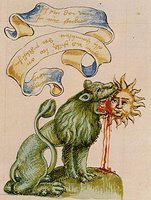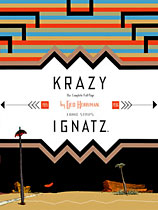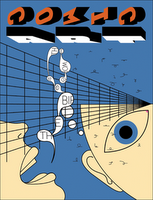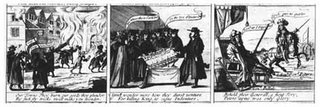




 From Bill Blackbeard's introduction to Krazy & Ignatz 1935-1936: "A Wild Warmth of Chromatic Gravy":
From Bill Blackbeard's introduction to Krazy & Ignatz 1935-1936: "A Wild Warmth of Chromatic Gravy":"There are just over four hundred and fifty of them, and each one a masterpiece of graphic comedy. The marvelous product of the last nine years of Garge's richly fruitful life, these weekly color Krazy Kat pages, stunning as they are, almost failed to physically survive the editorial and institutional rigors of their time. We are, in fact, damned lucky to have them on hand at all as source material for this series. There were, you see, just two newspapers -- six day a week sports and crime news afternoon newspapers, throwaway rubbish -- that printed virtually all of the color Kat pages from start to finish. Neither the New York Journal nor the Chicago American, sensational Hearst papers, had anyreferential status at all, and most libraries in their sales areas shunned them -- two papers that virtually no one of any artistic or literary taste and judgment ever saw fro mthe the strip's 1935 start to its 1944 conclusion. Two tombs for the foremost comic strip of all time.
Luckily there was a single dedicated comic strip buff, August Derleth of Sauk City Wisconsin, founder of Arkham House in 1939, who clipped and saved every color Kat page, donating his run to the Wisconsin State Historical Society..."

"...a man named Blackbeard told a reporter that he had a story for me...Blackbeard had a formal, slightly breathless way of talking; he was obviously intelligent, perhaps a little Ancient Marinerian in the way that lifelongcollectors can be...Some of what Blackbeard told me I couldn't quite comprehend: that the Library of Congress, [esp. arch-villain Verner Clapp, pictured left -kh.] the purported library of last resort, had replaced most of its enormous collection of late-nineteenth and twentieth-century newspapers with microfilm, and that research libraries where relying on what he called "fraudulent" scientific studies when they justified the discarding of books and newspapers on the basis of diagnosed states of acidity and embrittlement.
...In 1967, filled with an ambition to write a history of the American comic strip, he'd discovered that libraries were getting rid of their newspaper collections...Unfortunately he was a private citizen--the library's charter permitted the transfer of material only to a non-profit organization. "I became a non-profit organization so fast you couldn't believe it," Blackbeard told me...He went around the country picking up newspaper volumes..."




 pictures in sequence," I kept finding so many other things that fit the definition which were clearly not comics. It was absurd, I thought, to think a gallery exhibition, a magazine article, or a cereal box all fit the formal definition of comics. But then after reading Nelson Goodman (via WJT Mitchell) I came to see that what was important wasn't so much the marks on the paper, it was how you read them. It's embarrassing to admit, but I remember my mind being blown by the realization that what we call "comics" wasn't best defined as a form, but as part of an ongoing historical process, the messy forces of culture and commerce driving image-text combos to evolve into a particular species of art form, which is still evolving. At the time I knew very little about biology, but now I see how the development of comics resembles the inelegant trial and error and "act of God" forces at work in biological evolution. Or maybe comics is something more like the development of an ecosystem?
pictures in sequence," I kept finding so many other things that fit the definition which were clearly not comics. It was absurd, I thought, to think a gallery exhibition, a magazine article, or a cereal box all fit the formal definition of comics. But then after reading Nelson Goodman (via WJT Mitchell) I came to see that what was important wasn't so much the marks on the paper, it was how you read them. It's embarrassing to admit, but I remember my mind being blown by the realization that what we call "comics" wasn't best defined as a form, but as part of an ongoing historical process, the messy forces of culture and commerce driving image-text combos to evolve into a particular species of art form, which is still evolving. At the time I knew very little about biology, but now I see how the development of comics resembles the inelegant trial and error and "act of God" forces at work in biological evolution. Or maybe comics is something more like the development of an ecosystem?

"[the print] does not imitate the continuous flow of topical events so much as it arrests the progress in a series of "stations" functioning as isolated, diagrammatic allegories...the labels [proto word balloons] inhabit an abstract hieroglyphic space generally incompatible with a dynamic narrative...the captions, not the labels, are leading the tale."

PBS: Although for years comics have been denigrated as a so-called "low art" category, it appears they're becoming more widely accepted and perhaps even validated as a form of art and a long literary narrative. Would you agree with this? Is "form" the right word here? Do you think that this kind of validation is inhibiting in any way, that comics are in danger of becoming less rebellious or creatively free because they're more accepted and being published in the mainstream?
Chris: "Form" seems fine, and sometimes I use the word "language," and while I am genuinely happy that I don't have to explain that I'm not an animator anymore when someone asks me what it is I do, I do worry that beginning cartoonists could feel somewhat strangled by the increasing critical seriousness comics has received of late and feel, like younger writers, that they have to have something to "say" before they set pen to paper. Many cartoonists feel even more passionate about this idea than I do, vehemently insisting that comics are inherently "non-art" and poop humor or whatever it is they think it is, but that attitude is a little like insisting that all modern writing should always take the form of The Canterbury Tales.
I'm all for anything and everything in comics; I started drawing them with the specific goal of finding out whether or not they were capable of expressing things other than jokes and contempt. To me, Robert Crumb is a perfect artist because he's one of the most visually sensitive people alive yet he's widely also known as one of the world's great curmudgeons, simply because his emotional range is so wide and his ability to see the world so perspicacious; all artists should hope to be so pluralistic. I do worry that museum shows and literary magazine appearances might start to cloud the general readership's ability to see comics clearly, as anything that's presented as high art immediately blurs a viewer's perceptions with thinking and theory, but I think it also means that more talented and thoughtful people will be attracted to it as a medium.
-Chris Ware, interviewed at pbs.org
What about Art Spiegelman’s work, which you’ve parodied several times?
RYAN: I do appreciate the comic magazine Raw that he put out in the ‘80s. I was a fan of that. Maus, I just thought was okay. Other than that, I guess, I kind of dislike the drive to make comics fine art and fine literature that he seems to promote.
What type of comics are you trying to promote?
RYAN: The other end of the spectrum. I’m doing trashy, weird, crazy, strange, bizarre, disgusting, filthy, horrible stuff that you wouldn’t see in a museum.
-Johnny Ryan interviewed at Wizard

During spring in Denmark, at approximately one half an hour before sunset, flocks of more than a million European starlings (sturnus vulgaris) gather from all corners to join in the incredible formations shown above. This phenomenon is called Black Sun (in Denmark), and can be witnessed in early spring throughout the marshlands of western Denmark, from March through to the middle of April. The starlings migrate from the south and spend the day in the meadows gathering food, sleeping in the reeds during the night. The best place to view this amazing aerial dance is in the place called "Tøndermarsken," where these pictures were taken (on April 5 from 19.30 to 20.30 local time).
-from Earth Science Pic of the Day
Click the image for a desktop sized pic.
If you'd like to read more about starlings, my book CURSES will be out in October.